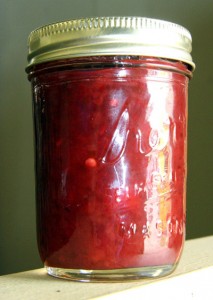EARTHTALK: Freezing foods without plastic
EARTHTALK: Freezing foods without plastic

Freezing foods in plastic containers isn’t as worrisome as heating them, but if you’re leery of plastic, glass containers designed to withstand large temperature extremes, such as Ball Jars (aka Mason jars), like the one pictured here, or anything made by Pyrex, can be a sensible alternative. Just be sure not to load them to the brim as some foods expand when frozen.
Dear EarthTalk: I love to cook and when I have the time I make soups, stews and pasta meals in large batches and freeze them. I use leftover plastic containers, but I know this is not good. What kinds of containers are safe for freezer food storage?– Kathy Roberto, via e-mail
Reusing leftover plastic food containers to store items in the freezer may be noble environmentally, but it might not be wise from the perspective of keeping food safely frozen and tasting its best when later heated up and served. Many such containers are designed for one-time use and then recycling, so it’s not worth risking using them over and over. Likewise, wax paper, bread wrappers and cardboard cartons should not be used to store frozen foods; these types of containers don’t provide enough of a barrier to moisture and odors and also may not keep food fresh when frozen.
Luckily though, many other materials are suitable for use as freezer-safe storage containers, at least according to the National Center for Home Food Preparation. To qualify as “freezer-safe,” the Georgia-based non-profit maintains, food storage containers must resist moisture-vapor, oil, grease and water as well as brittleness and cracking at low temperatures, while being durable, leak-proof and easy-to seal. They must also protect foods from absorption of off-flavors or odors. “Good freezing materials include rigid containers made of aluminum, glass, plastic, tin or heavily waxed cardboard; bags and sheets of moisture-vapor resistant wraps; and laminated papers made specially for freezing,” reports the group.
As to the leaking of unsafe constituent chemicals (BPA, phthalates, etc.) from certain plastics into foods, freezing is generally less of a threat than heating, but it is better to avoid plastics known to be problematic anyway just to be safe. Polycarbonate plastic, marked with #7, contains BPA while polyvinyl chloride, marked with #3, contains potentially harmful phthalates. If a plastic item does not bear a recycling number on its bottom, steer clear as it may well be a mix, which classifies it as a #7 polycarbonate.
Of course, the majority of plastic containers designed for freezer use are safe and, since they can be washed and reused, are a better choice than disposable freezer bags and wraps. For those still leery of using plastic at all, glass containers designed to withstand large temperature extremes, such as Ball Freezing Jars (Mason jars) or anything made by Pyrex-regular glass containers could break when frozen or if thawed too quickly-can be a sensible alternative. Also, beware of loading up glass containers to the brim before freezing; some foods expand when frozen so leaving a little extra room between the top of the food and the bottom of the (airtight) lid is always a good idea.
However you store your frozen delicacies, keep in mind that freezing food may inactivate microbes like bacteria and mold but may not destroy them. According to dietician and author Elaine Magee on the MedicineNet website, just thawing out frozen foods doesn’t necessarily mean they are automatically safe to eat. Foods that require cooking still require cooking for health’s sake after thawing. Also, Magee recommends quickly labeling and dating any foods you are freezing to facilitate purging of potentially spoiled or tasteless food down the line.
CONTACTS: National Center for Home Food Preparation, www.uga.edu/nchfp/; Pyrex, www.pyrex.com; Ball, www.freshpreserving.com; MedicineNet, www.medicinenet.com.
EarthTalk(r) is written and edited by Roddy Scheer and Doug Moss and is a registered trademark of E – The Environmental Magazine (www.emagazine.com). Send questions to: earthtalk@emagazine.com. Subscribe: www.emagazine.com/subscribe. Free Trial Issue: www.emagazine.com/trial.



Comments (0)